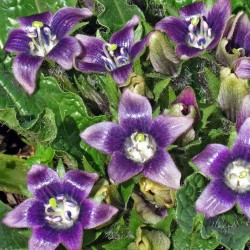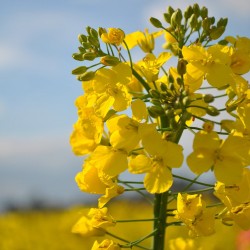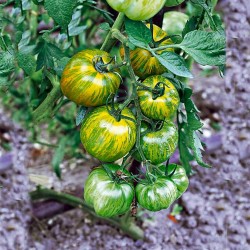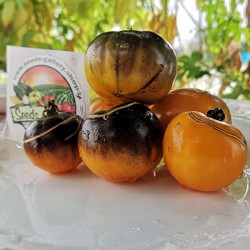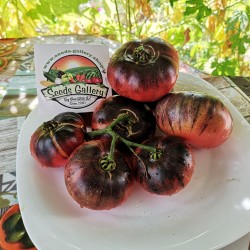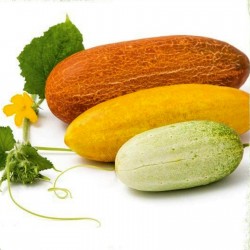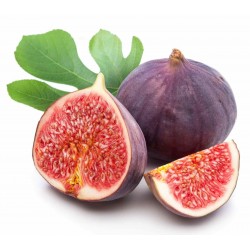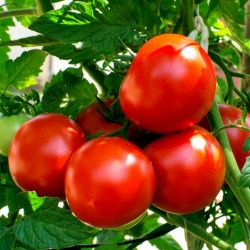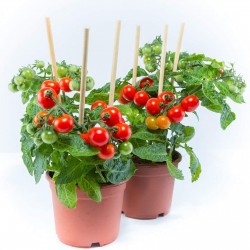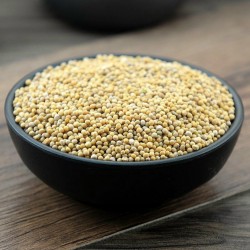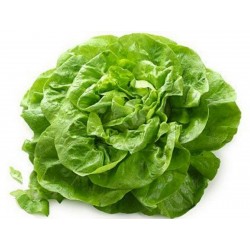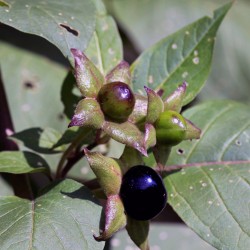
Rulík zlomocný semínka...
Cena
3,75 €
SKU: MHS 58
Seeds Gallery Com,
5/
5
<!DOCTYPE html>
<html>
<head>
<meta http-equiv="Content-Type" content="text/html; charset=UTF-8" />
</head>
<body>
<h2><strong>Rulík zlomocný semínka (Atropa bella-donna)</strong></h2>
<h2><span style="color: #ff0000;"><strong>Cena za balení 5 semen.</strong></span></h2>
<p>Atropa Belladonna nebo <span style="color: #000000;"><strong>čertova třešeň</strong></span> se používá již více než dvě tisíciletí jako léčivo, kosmetika, jed a čarodějnice. Belladonna je vytrvalá, naočkovaná, rozvětvená rostlina, která dorůstá až do výšky 1,5 metru, s listy dlouhými 12-13 cm a fialovým stonkem. V zimě umírá a na jaře znovu klíčí.</p>
<p>Po staletí jej čarodějnice používaly ve vzorcích, benátské ženy obecně, a zejména „noční dámy“ pro rozšiřování očí, a v současné době se používá jako lék proti kinetóze, IBS a dalším střevním poruchám. Belladonna byla také používána k otrávení celé armády ve válce. Říká se, že Satan se osobně staral o tuto rostlinu a jeho malé „ďáblovy třešně“.</p>
<p>Obsahuje psychotropní / toxické / život zachraňující alkaloidy, včetně atropinu. Tato rostlina je lék, halucinogen a jed. Smrt může (a stane se) od špatně informovaných lidí, například tím, že budete jíst příliš mnoho zralých bobulí v koláčích, tak to nedělejte. Bobule jsou chutné (jedl jsem je sám a jsou docela chutné). Jedná se o rostlinu, která je primární složkou tajného recepturního nápoje „Flying Formula“, který čarodějnice používají po staletí.</p>
<p>Tato bylina ve vás může vyvolat pocit, že vaše duše cestuje, ale přílišná konzumace může být fatální. Může být také použit jako protijed při otravě plyny.</p>
<h3><strong>Kultura</strong></h3>
<p>Může se množit výsevem semen nebo řízků, i když se doporučuje použití semen. Semena by měla být vložena do horké vody několik hodin před setím. Potřebují čas na klíčení a potřebují vysokou vlhkost a teplo a při zachování všech nezbytných podmínek není klíčení skvělé. Rostliny ocení substrát kompostu s hnojem a vlhkým, stinným prostředím. Dusičnany a amoniakové soli jsou nejlepším hnojivem pro zdvojnásobení množství alkaloidů.</p>
<h3><strong>WIKIPEDIA:</strong></h3>
<p><b>Rulík zlomocný</b><span> (</span><i>Atropa bella-donna</i><span>) je statná, až 180 cm vysoká vytrvalá </span>bylina<span>. Je považována za nejnebezpečnější středoevropskou jedovatou rostlinu, odhaduje se, že otravy rulíkem zlomocným tvoří zhruba polovinu všech vážných otrav rostlinného původu na území </span>České republiky<span>. Přirozeně se vyskytuje na většině území </span>Evropy<span> (od </span>Španělska<span> po </span>Podněstří<span> a </span>Krym<span> a od </span>Středomoří<span> po jižní </span>Švédsko<span>) a některých místech v </span>Africe<span>; výskyt tohoto druhu v </span>Maroku<span> a </span>Alžírsku<span> byl však v poslední době zpochybněn.</span></p>
<h2><span class="mw-headline" id="Vzhled">Vzhled</span></h2>
<p>Statná 50–180 cm vysoká žlaznatě pýřitá bylina s tlustou přímou a větvenou<span> </span>lodyhou.<span> </span>Listy<span> </span>jsou střídavé (v<span> </span>květenství<span> </span>zdánlivě vstřícné) a různě velké, kopinatě vejčité až elipsovité, celokrajné, na bázi klínovitě zúžené, pýřité.</p>
<p>Kvete od června do srpna.<span> </span>Květy<span> </span>jsou nicí, zdánlivě úžlabní, jednotlivé, stopkaté, pětičetné, koruny trubkovitě zvonkovité (až 3 cm dlouhá), zvenčí hnědofialové, zevnitř lysé, hnědofialové, žlutošedé až žluté, načervenale mramorované. Cípy koruny jsou ohnuté.</p>
<p>Plodem<span> </span>je černá kulovitá<span> </span>bobule<span> </span>(14–18 mm v průměru) vyrůstající ze hvězdicovitě rozloženého kalichu. Zprvu chutná sladce, pak však dostává odpornou hořkou příchuť.</p>
<p>Roste roztroušeně na<span> </span>pasekách<span> </span>a okrajích<span> </span>lesů<span> </span>od pahorkatin do podhůří. Obecně preferuje pohostinné vlhké půdy zásaditého až slabě kyselého charakteru.</p>
<h2><span id="Lidov.C3.A9_n.C3.A1zvy"></span><span class="mw-headline" id="Lidové_názvy">Lidové názvy</span></h2>
<p>Beladona, blázníček, bláznivá čerešňa, bláznivá třešně, bláznivý lilek, bláznový lilek, černé divoké višně, černé třešně, černé višně, čertova čerešeň, čertova třešeň, čertův blázníček, hadí hrozinky, hadí střešně, krásavica, lesný lulok, lilek, lilek pošetilý, lolek, lulák, lulčí, lulek, lulík, lulkové korenie, lulkový koreň, lulok, nadragule, nemnica, němnice, nimnica, psinky, psí třešně, rozpuka, šalamoun, šalamounek, toten, vlčá jahoda, vlčí jahodník, vlčí třešně, vlčia čerešňa, vlčia jahoda, vlčie oko, zlá jahoda, zlatá kráska, oči krásné paní.</p>
<h2><span class="mw-headline" id="Jedovatost_a_otravy">Jedovatost a otravy</span></h2>
<p>Celá rostlina je prudce jedovatá vzhledem k vysokém obsahu tropanových alkaloidů (kořen až 1,5 %, listy 0,3 až 1,2 %, semena asi 0,8 %), z nichž rozhodující podíl tvoří L-hyoscyamin (až 70 % všech alkaloidů). Obsah alkaloidů kolísá nejen podle stanoviště a vlivem podnebí, ale i vlivem dne.<sup id="cite_ref-:0_1-0" class="reference">[1]</sup><span> </span>Tyto alkaloidy působí na autonomní nervový systém jako<span> </span>parasympatolytikum<span> </span>tím, že tlumí všechny muskarinové účinky acetylcholinu; utlumují srdeční činnost a způsobují zastavení dechu. Centrálně atropin značně dráždí, působí velké vzrušení a teprve ve velkých dávkách ochrnuje.<sup id="cite_ref-:1_2-0" class="reference">[2]</sup></p>
<p>Člověk<span> </span>se může otrávit jednak přímou konzumací plodů, nebo přes<span> </span>kozí mléko<span> </span>či kozí maso, pokud<span> </span>koza<span> </span>tuto rostlinu sežere. Smrtelnou dávkou jsou u malého dítěte už 3 bobule(!), u dospělého asi 10.</p>
<p>Jako<span> </span>protijed<span> </span>(antidotum) se užívá<span> </span>fyzostigmin<span> </span>nebo<span> </span>pilokarpin.</p>
<p>Hlavní příznaky otravy:</p>
<ul>
<li>rozšířené zorničky</li>
<li>vyschlé sliznice</li>
<li>zčervenání obličeje, suchá teplá pleť</li>
<li>zrychlený tep</li>
</ul>
<p>Suchost v hrdle a zčervenání se dostavují již po léčebných dávkách. Po 5 mg lehké vzrušení, sklon k mluvení a pohybům, touha po procházkách, zčervenání v obličeji, suchost kůže, palpitace a mydriasa. Po větších dávkách vázne polykání, vzrušení se stupňuje, dýchání je obtížné, teplota stoupá, otrávený má závratě, vrávorá, má zrakové, sluchové i čichové halucinace, velmi pohyblivé a mnohotné. Po vybití sil zuřivostí nastává vyčerpání, slabost, spavost, klesá teplota.<sup id="cite_ref-:1_2-1" class="reference">[2]</sup><span> </span>Hluboký spánek může skončit smrtí z obrny dýchacího ústrojí.<sup id="cite_ref-:0_1-1" class="reference">[1]</sup><span> </span>Vzdor vysoké toxicitě rulíku je prognóza intoxikací vcelku příznivá vzhledem k dobře známým fyziologickým účinkům těchto látek a možnosti účinné léčby (fyzostigmin).<sup id="cite_ref-3" class="reference">[3]</sup></p>
<h2><span id="Vyu.C5.BEit.C3.AD"></span><span class="mw-headline" id="Využití">Využití</span></h2>
<p>Ze sušených listů (<i>Folium belladonnae</i>) a kořene (<i>Radix belladonnae</i>) této rostliny se získává atropin, ze kterého se vyrábějí<span> </span>atropinové kapky<span> </span>užívané v očním<span> </span>lékařství<span> </span>k rozkapávání očí za účelem usnadnění některých typů očních vyšetření (atropin roztahuje zorničky). Ze stejného důvodu si dívky ve starověku a středověku vtíraly šťávu z rulíku do očí, aby je měly krásně veliké. Odtud také pochází druhové jméno rostliny (<i>bella donna</i><span> </span>= krásná paní). Bylo to účinné, nepříliš praktické (dočasně to zhoršuje kvalitu<span> </span>zraku, při dlouhodobém používání se zrak může zhoršit trvale) a nebezpečné (mohlo dojít k nebezpečnému zánětu oka nebo otravě).</p>
<p>Výtažek z listů (<i>Belladonnae folii extractum siccum normatum</i>) se rovněž využívá proti křečím hladkého<span> </span>svalstva<span> </span>(spasmolytikum), obvykle však pouze ve směsích s<span> </span>analgetiky.</p>
<p>Není divu, že se rulík díky svým účinkům významně uplatňoval v bílé i černé magii. Byl např. složkou mastí, jejichž aplikace mohla vyvolávat narkotické stavy a pohybové halucinace (létání na koštěti!), jak nasvědčují např. doklady z inkvizičních procesů.</p>
</body>
</html>
MHS 58 (5 S)





